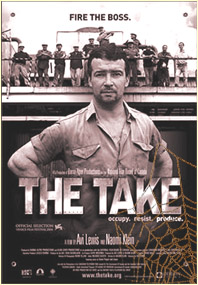Issue 13
Donya Ziaee
Student of Political Science and Near and Middle Eastern Civilizations
 How successful has Argentina been in the last ten years as the poster-boy for neo-liberalism? Perhaps the facts can speak for themselves. By late 2001, following more than a decade of rigorous compliance to mandates set by the International Monetary Fund (IMF) and the World Bank, Argentina faced a devastating economic collapse. The currency lost two thirds of its value; over 50% of Argentines fell below the poverty line; and the population was locked out of its own bank accounts. The people’s reaction? Widespread acts of major civil disobedience. The Target? “The Model.”
How successful has Argentina been in the last ten years as the poster-boy for neo-liberalism? Perhaps the facts can speak for themselves. By late 2001, following more than a decade of rigorous compliance to mandates set by the International Monetary Fund (IMF) and the World Bank, Argentina faced a devastating economic collapse. The currency lost two thirds of its value; over 50% of Argentines fell below the poverty line; and the population was locked out of its own bank accounts. The people’s reaction? Widespread acts of major civil disobedience. The Target? “The Model.”
The debate over the consequences of the implementation of the mandates of the IMF and the World Bank has long dominated discourse on development in various countries in the developing world. The claims of those against the execution of the regulations set forth by these two major financial agencies, established in Bretton Woods in 1944 with the intention of promoting trade and providing financial assistance, are vigorously defended by Avi Lewis and Naomi Klein in their ambitious new documentary, “The Take.” With extraordinary footage from Argentina following its economic collapse in December 2001, the Canadian team manages to effectively portray the failure of the neo-liberal economic model to provide for the masses in Argentina and thus raises the possibility of finding an alternative to the current surge of global capitalism.
Immediately followed by President Menem’s election in 1989 were policies implemented to make Argentina the ideal model of the IMF and the World bank, with all national assets privatized, markets deregulated and, as a result, unemployment soaring at an unprecedented rate in the country. Klein and Lewis do an outstanding job in depicting the extensive opposition and explicit resistance to such policies and in illustrating the efforts of the populace to make visible a widespread hostility towards their living conditions.
Discontented laid-off factory workers were the first to turn the prevalent opposition into a constructive movement, mainly by organizing assemblies in which they planned takeovers of abandoned and closed factories. The success of the occupation of the Zanón Ceramics and the Brukman garment factories by their workers in late 2001 set in motion a series of attempts by other laid-off workers to strive for reacquiring their jobs and obtaining through the factories’ profits the money owed to them.
Following the country’s economic collapse, many health clinics, schools, banks, bakeries and much more followed suit, equalizing salaries and involving all workers in every aspect of decision-making. “The Take” takes us through the strenuous and fascinating efforts of former workers of the Forja Auto Parts factory to win legal rights over its occupation, detailing with passion the obstacles facing these jobless Argentines. We are introduced to the family of the workers’ leader and witness the pain and frustration of his wife at her inability to manage both debts and feeding her two very young daughters. The film is as such very multi-dimensional, portraying not only the economic needs of the masses but also the underlying emotional suffering of those directly affected by their government’s neo-liberal agenda.
Another dimension to which the film alludes is the conflict over political views between the present generations in Argentina, making a broader point about a current generational divide in opinion worldwide. We observe a young girl working at the Zanón Ceramics factory who refuses to vote in the country’s 2003 elections clash with her mother who still has hopes for an effective governmental role in reconstruction. The quarrel between the two perhaps reveals the new generation’s disillusionment, not just in Argentina but also in various other developing countries, with state-imposed changes and an enthusiasm for bottom-up reform instead.
This fondness of bottom-up, grassroots action is prevalent in many other developing countries around the world. Dissatisfaction with market-oriented, trickle-down reform, and as well with state-imposed socialist development, such as has occurred in Cuba or Russia, has been the driving force behind the escalation of such sentiments. “The Take” skillfully captures the spirit of these mind-sets, as apparent in Argentina, and the people’s yearning for running their own affairs. The success and popularity of the occupied factories in the country for their direct democratic approach and their “by all for all” attitude is clear evidence of such aspirations.
It must also be said, however, that the film does not seek to present a precise plan of resistance against “the model” and that its survey of occupied factories should not necessarily be viewed as a prescription for discontented workers worldwide. During the question and answer period with the filmmakers following its benefit screening, many in the audience posed questions which concerned the technicalities of taking over a factory and its possibility in different circumstances. Naomi Klein accurately pointed out that the objective of the film had been to show the spirit of the workers’ efforts and not any specific particularities. Moreover, the film also alludes to occupied factories which do not in fact have equalized salaries and which do not involve all workers in decision-making. The film is effective, thus, not because it provides a grand design for resistance but because of its remarkable success in capturing the true soul and essence of the movement and of the desire for grassroots activism.
The economic policies of the Argentinean government may be global, but so is the resistance.
The poster-boy of neo-liberalism faces growing opposition by its population who simply refuse to surrender to the injustices imposed upon them. Menem’s dropping out of the May 2003 elections and the success of the Brukman garment factory workers to win back their factory after hundreds of police officers evicted it in April of the same year are only some evidence of the relative success of the grassroots movement against the current state of affairs in the country. These accomplishments in Argentina provide hope, inspiration and encouragement for resisters worldwide and are perhaps reflective of a massive global movement about to unfold.
The situation in Argentina can to some extent act as a possible reprimand for current developments in Iran. Following the Islamic Revolution in the country, Khomeini took severe steps to nationalize all assets and effectively shut the Iranian economy to local private and foreign powers, mainly to consolidate his rule. Later, Rafsanjani’s election as president brought with it a five-year economic development plan, first implemented in 1989, which sought to liberalize the Iranian economy and encourage private-sector participation. The plan generally continues to be followed by President Khatami, albeit with a higher emphasis on foreign direct investment in Iran as well as cultural and political development.
Recently, in September of this year, the IMF applauded the recent economic development in Iran, mainly its real GDP growth and the decline in the unemployment rate, but insisted on higher economic efficiency and the fostering of private sector development and growth, through further privatization, trade liberalization, and financial sector reform. The pace of Iran’s implementation of propositions set forth by the IMF may not be as rapid as that of Argentina before its collapse, but its economy, dependent as it is on oil revenues, is a fragile one and thus faces an uncertain future. Much of Iran’s alleged recent economic success is owed directly to the current high oil prices and as such it is easy to perceive of a possible economic downfall in the absence of such conditions. Is a collapse, then, such as occurred in Argentina, in store for Iran? It is tempting to reject the materialization of such an occurrence in the immediate future, but if one considers the pace of the economic transformation in Argentina, it becomes necessary to examine more scrupulously the future of Iran’s unstable oil-reliant economy, the role that such dependence might play in the current process of liberalization, and the ultimate consequences that the country’s economic policies might have on its population.
The Take is currently playing at Carlton and Varsity Cinemas in Toronto for a limited time.












